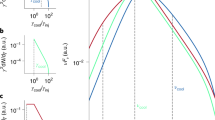Abstract
Gamma-ray bursts are among the most powerful events in nature. These events release most of their energy as photons with energies in the range from 30 keV to a few MeV, with a smaller fraction of the energy radiated in radio, optical, and soft X-ray afterglows1. The data are in general agreement with a relativistic shock model2, where the prompt and afterglow emissions3 correspond to synchrotron radiation from shock-accelerated electrons. Here we report an observation of a high-energy (multi-MeV) spectral component in the burst of 17 October 1994 that is distinct from the previously observed lower-energy γ-ray component. The flux of the high-energy component decays more slowly and its fluence is greater than the lower-energy component; it is described by a power law of differential photon number index approximately -1 up to about 200 MeV. This observation is difficult to explain with the standard synchrotron shock model2, suggesting the presence of new phenomena such as a different non-thermal electron process, or the interaction of relativistic protons with photons at the source.
This is a preview of subscription content, access via your institution
Access options
Subscribe to this journal
Receive 51 print issues and online access
$199.00 per year
only $3.90 per issue
Buy this article
- Purchase on Springer Link
- Instant access to full article PDF
Prices may be subject to local taxes which are calculated during checkout


Similar content being viewed by others
References
van Paradijs, J., Kouveliotou, C. & Wijers, R. A. M. J. Gamma-ray burst afterglows. Annu. Rev. Astron. Astrophys. 38, 379–425 (2000)
Mészáros, P. Theories of gamma-ray bursts. Annu. Rev. Astron. Astrophys. 40, 137–169 (2002)
Costa, E. et al. Discovery of an X-ray afterglow associated with the gamma-ray burst of 28 February 1997. Nature 387, 783–785 (1997)
Dingus, B. L. in High-Energy Gamma Ray Astronomy (eds Aharonian, F. A. & Völk, H. J.) 383–391 (AIP, New York, 2001)
Hurley, K. et al. Detection of a gamma-ray burst of very long duration and very high energy. Nature 372, 652–654 (1994)
Atkins, R. et al. Evidence for TeV emission from GRB 970417A. Astrophys. J. 533, L119–L122 (2000)
Dermer, C. D., Chiang, J. & Mitman, K. E. Beaming, baryon loading, and the synchrotron self-compton component in gamma-ray bursts. Astrophys. J. 537, 785–795 (2000)
Zhang, B. & Mészáros, P. High-energy spectral components in gamma-ray burst afterglows. Astrophys. J. 559, 110–122 (2001)
Katz, J. I. Delayed hard photons from gamma-ray bursts. Astrophys. J. 432, L27–L29 (1994)
Harris, M. J. & Share, G. H. A Search for hard-spectrum gamma-ray bursts using SMM. Astrophys. J. 494, 724–733 (1998)
Paciesas, W. S. et al. The fourth BATSE gamma-ray burst catalog (revised). Astrophys. J. Suppl. 122, 465–495 (1999)
Esposito, J. A. et al. In-flight calibration of EGRET on the Compton gamma-ray observatory. Astrophys. J. Suppl. 123, 203–217 (1999)
Preece, R. D. et al. The BATSE gamma-ray burst spectral catalog. I. High time resolution spectroscopy of bright bursts using high energy resolution data. Astrophys. J. Suppl. 126, 19–36 (2000)
Briggs, M. S. et al. in Gamma-ray Bursts (eds Meegan, C. A., Preece, R. D. & Koshut, T. M.) 299–303 (AIP, New York, 1998)
COMPTEL burst images and time profiles. 〈http://www.gro.unh.edu/bursts/cgrbdata.html〉; modified 13 August 1997.
Catelli, J. R. & Dingus, B. L. in Gamma-ray Bursts (eds Meegan, C. A., Preece, R. D. & Koshut, T. M.) 309–313 (AIP, New York, 1998)
González, M. M. et al. in Gamma-Ray Burst and Afterglow Astronomy 2001 (eds Ricker, G. R. & Vanderspek, R. K.) 267–269 (AIP, New York, 2003)
Band, D. et al. BATSE observations of gamma-ray burst spectra. I — Spectral diversity. Astrophys. J. 413, 281–292 (1993)
Thompson, D. J. et al. Calibration of the Energetic Gamma-Ray Experiment Telescope (EGRET) for the Compton Gamma-Ray Observatory. Astrophys. J. Suppl. 86, 629–656 (1993)
Liang, E. & Kargatis, V. Dependence of the spectral evolution of gamma-ray bursts on their photon fluence. Nature 381, 49–51 (1996)
Fishman, G. J. & Meegan, C. A. Gamma-ray bursts. Annu. Rev. Astron. Astrophys. 33, 415–458 (1995)
Zhang, B. & Mészáros, P. An analysis of gamma-ray spectral break models. Astrophys. J. 581, 1236–1247 (2002)
Inoue, S., Guetta, D. & Pacini, F. Precursor plerionic activity and high-energy gamma-ray emission in the supranova model of gamma-ray bursts. Astrophys. J. 583, 379–390 (2003)
Vietri, M. The acceleration of ultra-high-energy cosmic rays in gamma-ray bursts. Astrophys. J. 453, 883–889 (1995)
Waxman, E. Cosmological gamma-ray bursts and the highest energy cosmic rays. Phys. Rev. Lett. 75, 386–389 (1995)
Alvarez-Muñiz, J., Halzen, F. & Hooper, D. W. High energy neutrinos from gamma ray bursts: Event rates in neutrino telescopes. Phys. Rev. D. 62, 093015 (2000)
Boettcher, M. & Dermer, C. High-energy gamma rays from ultra-high-energy cosmic-ray protons in gamma-ray bursts. Astrophys. J. 499, L131–L134 (1998)
GLAST. 〈http://glast.gsfc.nasa.gov/〉; modified 29 April 2003.
Acknowledgements
We thank M. Harris for discussions, and D. L. Bertsch for assistance with accessing the EGRET data.
Author information
Authors and Affiliations
Corresponding author
Ethics declarations
Competing interests
The authors declare that they have no competing financial interests.
Rights and permissions
About this article
Cite this article
González, M., Dingus, B., Kaneko, Y. et al. A γ-ray burst with a high-energy spectral component inconsistent with the synchrotron shock model. Nature 424, 749–751 (2003). https://doi.org/10.1038/nature01869
Received:
Accepted:
Issue Date:
DOI: https://doi.org/10.1038/nature01869
This article is cited by
-
Gamma-ray bursts in the Swift-Fermi era: Confronting data with theory
Science China Physics, Mechanics and Astronomy (2010)
-
Spectral properties of Fermi/GBM gamma-ray bursts and the GeV emission detection rate with Fermi/LAT
Science China Physics, Mechanics and Astronomy (2010)
-
Ground-based calibration and characterization of the Fermi gamma-ray burst monitor detectors
Experimental Astronomy (2009)
-
Gamma-ray burst investigation via polarimetry and spectroscopy (GRIPS)
Experimental Astronomy (2009)
-
High-energy γ-ray emission from gamma-ray bursts — before GLAST
Frontiers of Physics in China (2008)
Comments
By submitting a comment you agree to abide by our Terms and Community Guidelines. If you find something abusive or that does not comply with our terms or guidelines please flag it as inappropriate.



